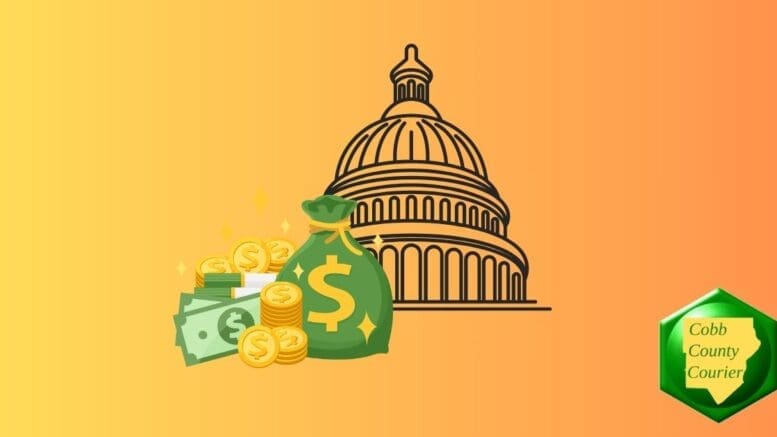By John A. Tures, Professor of Political Science, LaGrange College
“Sunlight is the best disinfectant,” Supreme Court Justice Louis Brandeis was once quoted as saying in Harper’s Weekly in 1913.
Many of us have heard of “dark money,” but that doesn’t mean we know what it means. Here’s more about what this money is, why the “dark” aspect can be problematic for you, and how the practice is really hampering the spirit of the law, and why 501(c)(4) groups were created in the first place.
According to OpenSecrets “Dark money” refers to spending meant to influence political outcomes where the source of the money is not disclosed.” That’s different from other kinds of campaign spending you’re probably more familiar with, where there are rules and limits on spending. Dark money is the antithesis of good government initiatives designed to level the playing field, provide accountability, and know who is penetrating our democratic policies.
You’ve probably heard of a “public charity,” a 501(c)(3) group. They’re different from these 501(c)(4) groups known as “social welfare organizations,” in a variety of ways, according to the Alliance for Justice. Like social welfare organizations, public charities can conduct public education and train people on the political process, educate candidates (thought they have to educate all candidates), sponsor debates inviting all candidates and provide equal opportunity to speak on the issues, give out voter guides on a number of issues, rent mailing lists to other groups and candidates (though there are rules on equal pricing), have non-partisan GOTV (get out the vote) voter registration drives, and have nonpartisan voter protection activities, and criticize officials, though such groups are heavily regulated.
Social welfare organizations, on the other hand, can do all of these, and a lot more, that public charities can’t. These 501(c)(4) groups also face less regulation on these activities. For example, the AFJ reveals that these so-called social welfare organizations can have unlimited lobbying for and against legislation and ballot measures, whereas 501(c)(3) groups are limited in both.
Those rules where groups have to apply equality to candidates and rent list prices don’t apply to 501(c)(4) groups. Moreover, they can do almost a dozen more practices than their public charity counterparts. They can (1) “distribute voter guides to the public that compare the candidates on issues of importance to the organization,” (2) “conduct voter registration and GOTV activities based on party affiliation or how people will vote.” These 501(c)(4) groups can also (3) “endorse candidates and publicize its endorsements,” (4) “fund independent expenditures in support of or opposition to a candidate,” and (5) “establish and pay for the administrative and fundraising costs of a connected political organization,” as well as (6) “criticize sitting elected officials (public charities have limits on this), and (7) “compare the organization’s issue position with that of a candidate.” Additionally, social welfare organizations can (8) “connect organization’s criticism of a public official to voting in an election,” (9) “highlight the differences between candidates for public office on a high-profile issue on which the candidates have diverging views,” (10) “ask candidates to sign pledges on any issue,” and (11) “post partisan political messages on social media,” all according to AFJ.
That’s a lot of power a 501(c)(4) social welfare organization has over a 501(c)(3) public charity, all without having to reveal a dime of where all that money is coming from. But there’s more bad news for advocates of getting too much money out of politics. According to the Non-Profit Quarterly, “The IRS has reportedly scaled back its oversight of social welfare organizations due to budgeting and other constraints, as well as complaints several years ago that it was only scrutinizing conservative 501c4s. It is also true that the number of social-welfare organizations has rapidly increased. This is due in part to the effect of the Citizens United decision on 501c4s, but there are other factors as well. For example, a recent article in Fortune tied the current volatile political climate to more groups choosing to organize themselves as 501c4s, because of the greater latitude a 501c4 designation provides when it comes to lobbying and political engagement.”
Brandeis’ quote does have a relevant ring to the dark money debate, according to Sunlight Foundation intern Andrew Berger. “Twenty years earlier, in a letter to his fiancée, Brandeis had expressed an interest in writing a ‘a sort of companion piece’ to his influential article on ‘The Right to Privacy,’ but this time he would focus on ‘The Duty of Publicity.’ He had been thinking, he wrote, ‘about the wickedness of people shielding wrongdoers & passing them off (or at least allowing them to pass themselves off) as honest men.’” Sounds like the Supreme Court Justice was anticipating our largely unregulated realm of campaign finance more than 100 years later.
John A. Tures is a professor of political science at LaGrange College in LaGrange, Georgia. His views are his own. He can be reached at jtures@lagrange.edu. His “X” account is JohnTures2.
